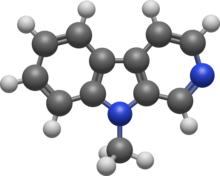9-Methyl-β-carboline

| |

| |
| Names | |
|---|---|
| Preferred IUPAC name
5-Methyl-5H-pyrido[3,4-b]indole | |
Other names
| |
| Identifiers | |
3D model (JSmol)
|
|
| ChemSpider | |
| MeSH | C529608 |
PubChem CID
|
|
| UNII | |
| |
| |
| Properties | |
| C12H10N2 | |
| Molar mass | 182.226 g·mol−1 |
Except where otherwise noted, data are given for materials in their standard state (at 25 °C [77 °F], 100 kPa).
| |
9-Methyl-β-carboline (9-Me-BC) is a heterocyclic amine of the β-carboline family, and a research chemical.[1]
Chemistry
[edit]9-Me-BC is a methylated derivative of β-carboline with the molecular formula C12H10N2.
It may be prepared by performing the Eschweiler–Clarke reaction on freebase β-carboline (norharmane) [citation needed]
Biological effects
[edit]In vitro studies with dopaminergic neuron cell cultures demonstrated increased expression of tyrosine hydroxylase and associated transcription factors, increased neurite outgrowth, regeneration of neurons after chronic rotenone administration, and reduced expression of inflammatory cytokines.[1] In studies of primary mesencephalic dopaminergic neuron cell cultures, the substance increased the number of differentiated dopaminergic neurons and produced higher levels of transcription factors associated with dopaminergic differentiation.[2] 9-Me-BC also inhibited the oxidation of the neurotoxin precursor MPTP to the dopaminergic neurotoxin MPP+ in vitro.[3]
Rodent studies in vivo demonstrated elevated hippocampal dopamine levels, improved spatial learning performance in a radial maze test, and increased dendrite outgrowth in the dentate gyrus of the hippocampus,[4] as well as restoration of the number of tyrosine hydroxylase expressing neurons in the left striatum after an injection of MPP+ had reduced the number of such cells by 50% in an animal model of Parkinsonism.[5]
9-Me-BC is a known inhibitor of monoamine oxidase A and monoamine oxidase B, and has been proposed for further investigation in the treatment of Parkinson's disease.[6]
It may possess photosensitizing effects.[7]
See also
[edit]References
[edit]- ^ a b Polanski W, Enzensperger C, Reichmann H, Gille G (2010). "The exceptional properties of 9-methyl-β-carboline: Stimulation, protection and regeneration of dopaminergic neurons coupled with anti-inflammatory effects". J Neurochem. 113 (6): 1659–1675. doi:10.1111/j.1471-4159.2010.06725.x. PMID 20374418.
- ^ Hamann J, Wernicke C, Lehmann J, Reichmann H, Rommelspacher H, Gille G (2008). "9-Methyl-β-carboline up-regulates the appearance of differentiated dopaminergic neurones in primary mesencephalic culture". Neurochem. Int. 52 (4–5): 688–700. doi:10.1016/j.neuint.2007.08.018. PMID 17913302. S2CID 24226033.
- ^ Herraiz T, Guillén H (2011). "Inhibition of the bioactivation of the neurotoxin MPTP by antioxidants, redox agents and monoamine oxidase inhibitors". Food Chem. Toxicol. 49 (8): 1773–1781. doi:10.1016/j.fct.2011.04.026. hdl:10261/63126. PMID 21554916.
- ^ Gruss M, Appenroth D, Flubacher A, Enzersperger C, Bock J, Fleck C, Gille G, Braun K (2012). "9-Methyl-β-carboline-induced cognitive enhancement is associated with elevated hippocampal dopamine levels and dendritic and synaptic proliferation". J Neurochem. 121 (6): 924–931. doi:10.1111/j.1471-4159.2012.07713.x. PMID 22380576.
- ^ Wernicke C, Hellmann J, Zieba B, Kuter K, Ossowska K, Frenzel M, Bencher NA, Rommelspacher H (2010). "9-Methyl-beta-carboline has restorative effects in an animal model of Parkinson's disease". Pharmacol Rep. 62 (1): 35–53. doi:10.1016/s1734-1140(10)70241-3. PMID 20360614. S2CID 16729205.
- ^ Polanski W, Reichmann H, Gille G (2011). "Stimulation, protection and regeneration of dopaminergic neurons by 9-methyl-β-carboline: a new anti-Parkinson drug?". Expert Rev Neurother. 11 (6): 845–860. doi:10.1586/ern.11.1. PMID 21651332. S2CID 24899640.
- ^ Vignoni M, Rasse-Suriani FA, Butzbach K, Erra-Balsells R, Epe B, Cabrerizo FM (2013). "Mechanisms of DNA damage by photoexcited 9-methyl-β-carbolines". Org Biomol Chem. 11 (32): 5300–9. doi:10.1039/c3ob40344k. hdl:11336/2178. PMID 23842892.

